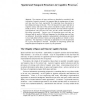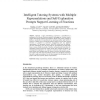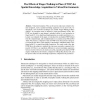219 search results - page 15 / 44 » Using Spatial Relations for Graphical Symbol Description |
CSL
2002
Springer
13 years 8 months ago
2002
Springer
A spoken language generation system has been developed that learns to describe objects in computer-generated visual scenes. The system is trained by a `show-and-tell' procedu...
ICMI
2003
Springer
14 years 1 months ago
2003
Springer
Many user interfaces, from graphic design programs to navigation aids in cars, share a virtual space with the user. Such applications are often ideal candidates for speech interfa...
BIRTHDAY
1997
Springer
14 years 19 days ago
1997
Springer
The structures of space and time are identified as essential for the realization of cognitive systems. It is suggested that the omnipresence of space and time may have been respons...
AIED
2009
Springer
14 years 3 months ago
2009
Springer
Although a solid understanding of fractions is foundational in mathematics, the concept of fractions remains a challenging one. Previous research suggests that multiple graphical r...
SG
2010
Springer
13 years 6 months ago
2010
Springer
Abstract. Virtual environments (VEs) can be used to study issues related to human navigation, such as spatial knowledge acquisition. In our prior work, we introduced a new locomoti...



